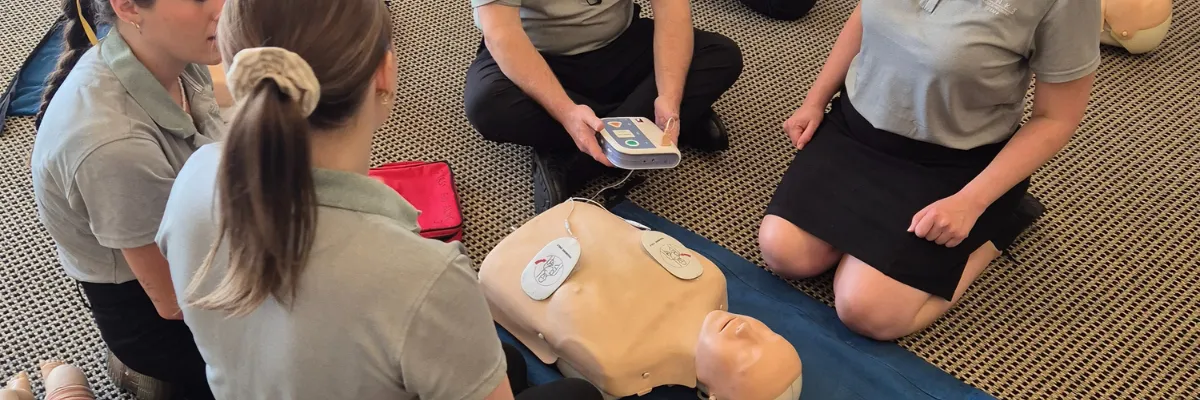
Safe Low Voltage Rescue Procedures: Essential Steps for Brisbane Electrical Workers
Every year in Australia, electrical incidents claim lives and cause serious injuries that could have been prevented with proper rescue procedures. As a Brisbane electrical worker, you know that working with electricity carries inherent risks, but are you truly prepared to respond when seconds count?
Low voltage doesn't mean low risk. In fact, voltages under 1000V AC are responsible for the majority of electrical injuries and fatalities in the workplace. Your UETDRRF004 certification isn't just a compliance checkbox—it's a critical skill set that could save your colleague's life.
This guide walks you through the essential before, during, and after stages of safe low voltage rescue procedures specifically relevant to Brisbane electrical workers. Whether you're due for recertification or looking to refresh your knowledge between formal training sessions, understanding these procedures can make the difference between life and death in an emergency.
We'll cover practical rescue techniques, equipment requirements, and post-incident protocols based on the latest electrical safety standards and regulations. By the end of this article, you'll have a clear action plan for responding confidently to low voltage incidents in your workplace.
What are the steps in low voltage rescue?
Low voltage rescue follows a sequential 5-step procedure to safely assist electrical shock victims:
Assess: Check scene safety and identify the electrical hazard without touching anything.
Isolate: Disconnect power by switching off at source, removing fuses, or using appropriate isolation equipment.
Approach: Only approach the victim after confirming power is isolated using proper verification techniques.
Rescue: Use insulated tools to remove victim from electrical contact if necessary. Never use bare hands.
Respond: Check consciousness and breathing. Begin CPR if needed and call emergency services (000). Apply AED if available.
Each step must be performed in order, without skipping any steps, even under time pressure. Following this procedure ensures rescuer safety while maximizing victim survival chances. Proper training through a certified UETDRRF004 course is essential for developing competence in these rescue techniques.

Before the Rescue: Preparation and Prevention
Look, I know what you're thinking - "I've been working with electricity for years, I know the risks." But trust me, I've seen experienced sparkies freeze up when a real emergency happens. Preparation isn't just about ticking boxes, it's about making sure you can act without hesitation when it matters most.
Essential LVR Equipment and Where to Place It
Let's be honest - having rescue equipment stored in some forgotten cupboard isn't gonna help anyone. You need your gear accessible and ready to go.
Here's what you absolutely need to have on hand:
Insulated rescue hooks (rated for appropriate voltage)
Insulated rubber mats (check them regularly for cracks or damage)
Insulated gloves (with current test dates - don't use expired ones)
Non-conductive rope for distance rescue
Face shield for CPR
First aid kit with burn treatment supplies
Clear emergency contact information
For Brisbane electrical workers, you need to test your insulated equipment every 6 months according to Queensland regulations. Don't skip this - WorkSafe inspectors check these records first thing after an incident.
Place your equipment:
Near main electrical panels or high-risk work areas
In clearly marked, accessible containers
Away from water or moisture sources
With simple visual instruction cards attached
I worked with a crew in Chermside last year who mounted their rescue equipment on a bright yellow backboard - made it impossible to miss and shaved crucial seconds off their response time during a drill.
Risk Assessment and Hazard Identification
Before you even pick up a tool, you gotta train your eyes to spot the dangers. Brisbane's humidity and summer storms create unique electrical hazards you might not find in other parts of Australia.
Common low voltage hazards in Brisbane worksites include:
Water ingress in outdoor equipment after heavy rain
Corroded connections in older buildings (especially near the coast)
Temporary wiring on construction sites
Damaged insulation from heat exposure in roof spaces
Incorrectly labeled circuits (a huge problem in older Brisbane buildings)
According to ESO Queensland, 65% of electrical incidents involve a hazard that was visible during pre-work inspection but went unreported.
Queensland electrical safety codes require documentation of your risk assessment. Don't just do it in your head - write it down, take photos of hazards, and make sure your whole team knows about them.
Team Training and Emergency Response Planning
Your UETDRRF004 certification is valid for 12 months, but don't wait until the last minute to refresh your skills. Most Brisbane electrical businesses now run monthly 15-minute refresher drills.
For effective team response:
Assign specific rescue roles based on team member strengths
Practice communication protocols - who calls emergency services?
Run surprise drills occasionally (they're annoying but effective)
Create simple response flowcharts and post them where everyone can see
A mate of mine who runs an electrical business in Springfield has his team practice one rescue scenario every Monday morning. He says it's cut their response time in half and built muscle memory for emergency actions.
During the Rescue: Step-by-Step LVR Procedure
When shit hits the fan, you don't have time to google what to do. These steps need to be automatic, which is why proper training matters so much.
Scene Assessment and Danger Control
The first 3 seconds after discovering an electrical incident are critical. Your brain wants to rush in and help - fight that instinct.
Do this instead:
Stop and visually scan the entire area
Identify the source of electricity
Check for other hazards (water, fire, falling objects)
Call out to alert others nearby
Decide whether to call 000 first or begin rescue
I've heard too many stories of double casualties because someone rushed in without proper assessment. Don't be that person.
If there are bystanders, give them clear, simple instructions:
"You - call 000 and say 'electrical emergency'"
"You - go to the main switchboard and wait for my instructions"
"Everyone else - stay back at least 10 meters"
Use a commanding voice and point directly at individuals. Being specific prevents the "someone else will do it" mentality.
Safe Power Isolation Techniques
This is where proper lockout/tagout procedures are non-negotiable. Different systems require different approaches:
For standard distribution boards:
Identify the correct circuit breaker
Switch off and lock if possible
Tag with your details
Try to verify isolation with a properly tested voltage indicator
For equipment with plug connections:
Disconnect at the plug if possible
Don't rely on just switching off - physically disconnect
Secure the plug so it can't be reconnected accidentally
When main switches are inaccessible:
Use insulated tools to create safe disconnection
Consider alternative power isolation points
In extreme emergencies, consider supply isolation at street level (but only if trained)
The most common mistake I see? Assuming a switch is off means it's safe. Always verify! I worked with an apprentice who got a nasty shock because he trusted a switch position without testing. Don't learn this lesson the hard way.
Approaching and Moving the Victim
Once you're 100% certain power is isolated, you can approach - but do it right.
Proper approach technique:
Maintain situational awareness
Use insulated equipment as a precaution
Move deliberately, not hastily
Communicate your actions clearly to team members
If the victim is still in contact with potential electrical sources:
Use a non-conductive implement to break contact
A dry wooden broom handle works in a pinch
Never use metal or wet materials
Don't touch the victim directly until contact is broken
For moving victims with suspected spinal injuries (common in fall-related electrical incidents):
Minimize movement if possible
Support head and neck
Move as a unit - no twisting
Only move if absolutely necessary for safety
CPR and First Aid for Electrical Shock Victims
Electrical shock victims need specific treatment considerations:
The CPR approach for electrical victims:
Check consciousness by shouting and gentle shoulder squeeze
Open airway, check breathing (look, listen, feel for 10 seconds)
If no normal breathing, begin CPR immediately (30 compressions, 2 breaths)
Continue until help arrives or victim recovers
What many people don't realize is that electrical shock victims can seem fine initially but deteriorate quickly due to cardiac arrhythmias. Always monitor for:
Irregular pulse
Confusion or disorientation
Breathing difficulties
Burns (both entry and exit points)
For electrical burns:
Cover with clean, dry dressing
Don't apply creams or ointments
Don't remove clothing stuck to burns
Document burn locations for paramedics
If using an AED, ensure the victim is on a dry surface and follow the device instructions precisely.

After the Rescue: Post-Incident Procedures
The incident isn't over when the ambulance leaves. What you do next matters for both compliance and preventing future incidents.
Immediate Post-Rescue Actions
Once emergency services arrive:
Provide clear handover information
Report exactly what happened
Detail any treatment provided
Identify potential entry/exit burn points
Share information about the electrical system involved
Secure the scene by:
Putting up barrier tape
Assigning someone to prevent access
Preserving evidence of what happened
Taking photos if safe to do so
Not disturbing equipment positions
After my neighbor's apprentice had a shock incident in Carindale, the supervisor's detailed handover to paramedics meant they could provide targeted cardiac monitoring that potentially saved the kid's life.
Incident Reporting and Documentation
Queensland's Electrical Safety Office requires formal reporting of serious electrical incidents within 24 hours. Don't drag your feet on this.
Your incident documentation should include:
Exact time and location
Persons involved
Equipment details
Sequence of events
Rescue procedures used
Outcomes and injuries
Witness statements
Digital tools like incident reporting apps make this process easier, but even a detailed written account is better than nothing. Be honest - covering up details can lead to prosecution.
Equipment Restoration and System Checks
After an incident, don't just reset and continue. Full system integrity needs verification.
Post-incident equipment checks:
Inspect all potential sources of the fault
Test insulation resistance where appropriate
Check earth continuity
Verify RCD operation
Inspect for damage to nearby equipment
Replace any rescue equipment that was used
Any rescue equipment that made contact with electrical current should be replaced or recertified before being returned to service. This is a compliance requirement in Queensland.
Document all testing procedures and results - this provides both safety assurance and liability protection.
Psychological Support and Team Debriefing
This part gets overlooked too often. Electrical incidents can be traumatic for everyone involved - not just the victim.
After a serious incident:
Hold a team debrief within 24 hours
Discuss what happened factually, without blame
Identify what went well and what could improve
Watch for signs of distress in team members
Offer professional support options
Signs someone might need additional support:
Unusual quietness or withdrawal
Increased irritability
Sleep disturbances
Reluctance to return to similar work
Repeatedly discussing the incident
Brisbane has good resources for electrical workers dealing with incident trauma. The Electrical Trades Union can connect workers with counseling services, and many employers now offer EAP (Employee Assistance Program) support.
I know a contractor who experienced a serious incident in Ipswich last year - said the psychological debrief was as important as the technical investigation for getting his confidence back.
Ready to Update Your Low Voltage Rescue Skills?
Knowing proper safe low voltage rescue procedures isn't optional if you're working in the electrical trade. It's a skill that might save your workmate's life.
Brisbane First Aid Training offers specialized UETDRRF004 courses designed specifically for electrical workers, with practical scenarios based on real Brisbane workplace incidents. Our trainers have actual electrical industry experience and understand the unique challenges you face on site.
Book your certification or refresher course today - we offer early morning, evening and weekend sessions to fit around your work schedule, with training locations at the Corner of Lalina and McFarlane St, Riverhills, Brisbane, QLD, 4074.
Don't wait until your certification expires. Call us on 0434778243 | 04FIRSTAID or click the booking button below.


